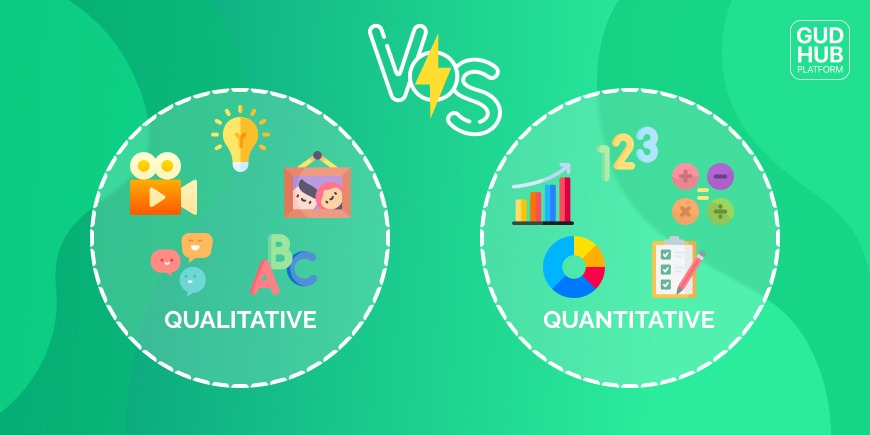Qualitative vs quantitative: complex terms in simple words
Quantitative and qualitative data Intro
Technology development relies heavily on research — gathering information or data to generate new knowledge. This is necessary to provide supporting data. Quantitative and qualitative data go hand in hand. But we often find cases where marketers struggle to choose between quantitative and qualitative research. This is because many of us are unaware of the difference between quantitative data vs qualitative data and their use. Qualitative vs quantitative research do not exclude each other, but, on the contrary, complement each other favorably.
But it is very important to know how quantitative vs qualitative research methods differ, what information they can give and how to use qualitative and quantitative data correctly. We will talk about this further.
Difference between quantitative and qualitative data
In short, quantitative data provide numbers for a general idea of a particular situation related to a product, service, service level, etc. And qualitative data clarifies these general points - they make them more detailed. When the first type of data is accurate, factual, convincing, the second one is subjective, interpretive, investigative.
Now let's take a closer look.
What is quantitative data?
Quantitative data is defined as any data in numerical form such as statistics, percentages, etc. Such type of data collected can be processed by statistical methods and get some specific indicators. Quantitive data can be used in calculations and statistical tests. Quantitative data may include measurements such as height, weight, volume, length, size, humidity, speed, age, etc. Tabular and schematic presentation of data is also possible in the form of charts, graphs, tables, etc. In addition, quantitative statistical data can be classified as discrete or continuous variables used to collect data:
- Reviews
- Experiments
- Observations and interviews
Qualitative vs quantitative data have their strong sides.
The specific quantitative data are clear and specific to the survey conducted.
High reliability. When collected correctly, quantified data are usually accurate and therefore very reliable.
Quantitative data examples:
- If you survey the satisfaction of participants and ask them to rate their experience on a scale of 1 to 5. You can collect grades and ratings. Numerical in nature, you will use statistical methods to conclude participant satisfaction.
- After a survey, you can understand that 70% of your website visitors do not use regular promotions, which are located in a special section.
- It also can look like this: 150 people downloaded your free e-book; 50 respondents didn't like a new feature in your app, etc.
What is qualitative data?
Let’s move to the qualitative data definition. Qualitative data is a collection of information that cannot be measured with numbers. It typically consists of words, subjective narratives. Qualitative data statistics are based on different information: impressions, opinions, views of different people. Data qualitative describes characteristics and qualities. Qualitative data analysis can result in keyword extraction, information extraction, and concept development.
Qualitative data described in:
- Texts of interviews and focus groups
- Audio recordings of everyday dialogues
- Drawings
- Texts and images of the mass media
- Diaries
- Qualitative responses
- Letters, etc.
Better understanding. Qualitative data provides a better understanding of the perspectives and needs of the participants.
Explanation. Qualitative data, together with quantitative data, can explain the survey results.
Better identification of behavior patterns. Qualitative data can provide detailed information that can be useful in identifying patterns of behavior.
What is an example of qualitative data?
- Let's go back to the example with the website, then you can find out that people do not use promotions for certain reasons: they are unprofitable, differ in too complicated conditions, are not associated with products (in the same luxury segment), etc. That is qualitative information.
- A study of the perception of parents about the existing education system for their children. The information received from them can be presented in the form of a story, and you need to conclude that the analysis is satisfied, dissatisfied, or requires improvement in certain areas, etc.
What is the difference between quantitative and qualitative data?
Look at the comparison.
| Cell | Qualitative data | Quantitative data |
Specificity | Can be categorized according to characteristics and features | Can be measured, counted, and expressed numerically |
Research methodology | Exploratory | Final |
Approach | Subjective | Objective |
Analysis | Non-statistical | Statistical |
Can be generated/obtained with | Observations and notes, texts, documents, audio/video recording, interview transcripts, focus group transcripts, | Experiments, tests, metrics, reviews, market reports |
Data collection | Unstructured | Structured |
Question | Why? | How much? |
Result | Develops initial understanding | Recommends a final action plan |
Summarize. Quantitative data can be measured in numbers. Thus, an objective and convincing result can be obtained. On the other hand, qualitive data cannot be measured in numbers. It is descriptive and therefore you cannot get an objective result. Rather, it gives you a subjective approach to problem-solving and often lays the foundation for quantitative analysis.
Quantitative research vs qualitative research
Quantitative research, as the name implies, involves counting observations. It is conducted based on data collected through various forms of closed-ended question surveys, personal interviews, etc. Quantitative research data is conducted to develop theories, statistical models, hypotheses, etc. Typically, answers to quantitative analysis are questions such as “How much” and “how often”.
The type of quantitative research familiar to most people has applied population statistics, the proportions of different categories of people are used (for example, 30% of women, 10% of the unemployed, etc.). Research of such type helps to understand what might happen in the future. However, such research contains very little information about feelings or motivation. Qualitative research can provide more information on this.
Qualitative research is a research strategy that focuses on describing an observation or data. It is conducted based on data collected first-hand, in focus groups, customer surveys with open questions, questionnaires, etc. This type of research is a way to understand the reasons for certain consumer behaviors, opinions, attributes, and experiences. Such research helps to look deeper into a problem or helps to develop ideas or hypotheses for potential quantitative research. Typically, the qualitative analysis answers the "why" question.
What is the difference between qualitative and quantitative research with examples?
Let’s compare.
Quantitative research | Qualitative research |
Belong to exact disciplinesExample of text inside paragraph | Belong to the humanities |
Objective | Subjective |
A deductive method of analysis is used to synthesize data | The inductive analysis method is used for data synthesis |
Concentrating on brevity and precision | Focus on complexity and scale |
Testing the theory | Development of the theory |
The basis for Learning: Causal Relationships | The basis for gaining knowledge: meaning, context |
Key elements of analysis: measurements and statistical analysis | Key elements of analysis: words, narration |
A single reality that can be measured and generalized | Many realities that are constantly changing, taking into account individual interpretations |
Examples: Application forms, measurements, tests | Examples: Document review, unstructured interviews, and observations |
Qualitative vs quantitative research methods
Quantitative research methods
Methods for collecting quantitative data differ in techniques that are unstructured or semi-structured. Some common methods include focus groups (group discussions), one-to-one interviews, and participation and/or observation. The sample size is usually small and the quota provided is taken into account in selecting respondents. Interaction between researchers and research participants is at the heart of qualitative research methods.
Qualitative research methods
When conducting qualitative research, data collection can also be carried out from documents and other written sources. In addition to collecting data that reflects thoughts and expressions, the definition of qualitative research also includes characteristics that are different from quantitative research. For example, what has become known today within a separate group cannot be generalized, or will change over time.
Quantitative and qualitative as mixed methods
Quantitative versus qualitative research methods can complement each other and may even appear to be similar. For example, using a questionnaire may be considered qualitative research, but maybe quantitative, depending on how the questionnaire is framed.
Research is not necessarily wholly qualitative or quantitative. A popular type of research is called "mixed methods" research, which uses both qualitative and quantitative methods. Researchers deliberately combine quantitative and qualitative data instead of analyzing them separately.

The balance between qualitative and quantitative data research
Qualitative research is almost always done first - when it is clear that there is a task or a problem, but there is no structured information yet. When the answers are received from the respondents and are processed, there is already a starting point for further research - and here quantitative methods will come in handy. They will help to understand to what extent a particular difficulty or a wish voiced by a person is relevant to the audience. After obtaining the exact numbers, something can be discarded - and something can be given more attention.
Outcome
Numbers are by far the most accurate form of data representation and, in this sense, have a significant advantage over quality data. But winning inaccuracy, numbers lose in semantic fullness. Formalization is a path not only to an increase in accuracy but also to a loss of meaningful information. That is why it is not right to choose between qualitative versus quantitative data. The possibility of flexible work with various types of data, the use of both quantitative and qualitative methods will be the best way to achieve the desired result.
In this article, we considered quantitative vs qualitative data definitions, figured out what is qualitative and quantitative research, gave examples, and explained why qualitative data vs quantitative data and researches work together better.


